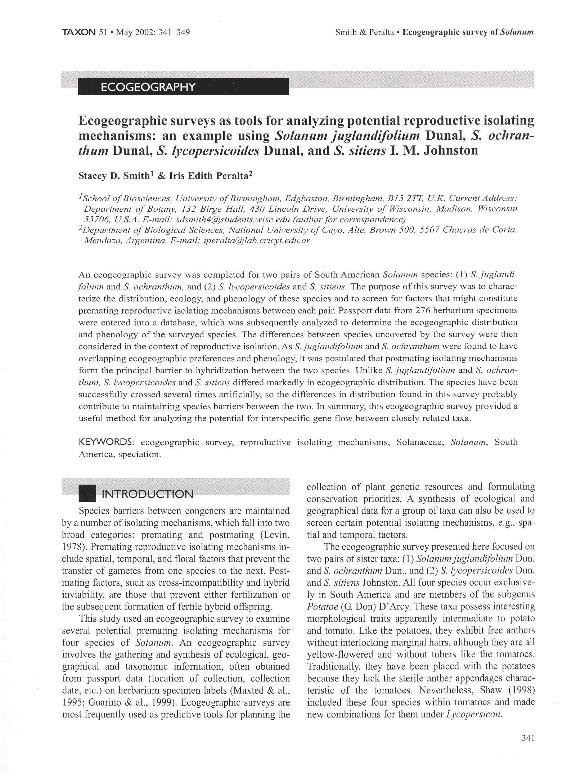Mostrar el registro sencillo del ítem
dc.contributor.author
Smith, Stacey Dewitt

dc.contributor.author
Peralta, Iris Edith

dc.date.available
2022-11-08T18:26:30Z
dc.date.issued
2002-05
dc.identifier.citation
Smith, Stacey Dewitt; Peralta, Iris Edith; Ecogeographic surveys as tools for analyzing potential reproductive isolating mechanisms: an example using Solanum juglandifolium Dunal, S. ochranthum Dunal, S. lycopersicoides Dunal, and S. sitiens I. M. Johnston; International Association for Plant Taxonomy; Taxon; 51; 2; 5-2002; 341-349
dc.identifier.issn
0040-0262
dc.identifier.uri
http://hdl.handle.net/11336/176930
dc.description.abstract
An ecogeographic survey was completed for two pairs of South American Solanum species: (1) S. juglandifolium and S. ochranthum, and (2) S. lycopersicoides and S. sitiens. The purpose of this survey was to characterize the distribution, ecology, and phenology of these species and to screen for factors that might constitute premating reproductive isolating mechanisms between each pair. Passport data from 276 herbarium specimens were entered into a database, which was subsequently analyzed to determine the ecogeographic distribution and phenology of the surveyed species. The differences between species uncovered by the survey were then considered in the context of reproductive isolation. As S. juglandifolium and S. ochranthum were found to have overlapping ecogeographic preferences and phenology, it was postulated that postmating isolating mechanisms form the principal barrier to hybridization between the two species. Unlike S. juglandifolium and S. ochranthum, S. lycopersicoides and S. sitiens differed markedly in ecogeographic distribution. The species have been successfully crossed several times artificially, so the differences in distribution found in this survey probably contribute to maintaining species barriers between the two. In summary, this ecogeographic survey provided a useful method for analyzing the potential for interspecific gene flow between closely related taxa.
dc.format
application/pdf
dc.language.iso
eng
dc.publisher
International Association for Plant Taxonomy

dc.rights
info:eu-repo/semantics/openAccess
dc.rights.uri
https://creativecommons.org/licenses/by-nc-sa/2.5/ar/
dc.subject
ECOGEOGRAPHIC SURVEY
dc.subject
REPRODUCTIVE ISOLATING MECHANISMS
dc.subject
SOLANACEAE
dc.subject
SOLANUM
dc.subject
SOUTH AMERICA
dc.subject
SPECIATION
dc.subject.classification
Ciencias de las Plantas, Botánica

dc.subject.classification
Ciencias Biológicas

dc.subject.classification
CIENCIAS NATURALES Y EXACTAS

dc.title
Ecogeographic surveys as tools for analyzing potential reproductive isolating mechanisms: an example using Solanum juglandifolium Dunal, S. ochranthum Dunal, S. lycopersicoides Dunal, and S. sitiens I. M. Johnston
dc.type
info:eu-repo/semantics/article
dc.type
info:ar-repo/semantics/artículo
dc.type
info:eu-repo/semantics/publishedVersion
dc.date.updated
2021-02-18T15:21:41Z
dc.journal.volume
51
dc.journal.number
2
dc.journal.pagination
341-349
dc.journal.pais
Austria

dc.journal.ciudad
Viena
dc.description.fil
Fil: Smith, Stacey Dewitt. University of Birmingahm; Reino Unido
dc.description.fil
Fil: Peralta, Iris Edith. Consejo Nacional de Investigaciones Científicas y Técnicas. Centro Científico Tecnológico Conicet - Mendoza. Instituto Argentino de Investigaciones de las Zonas Áridas. Provincia de Mendoza. Instituto Argentino de Investigaciones de las Zonas Áridas. Universidad Nacional de Cuyo. Instituto Argentino de Investigaciones de las Zonas Áridas; Argentina. Universidad Nacional de Cuyo. Facultad de Ciencias Agrarias; Argentina
dc.journal.title
Taxon

dc.relation.alternativeid
info:eu-repo/semantics/altIdentifier/url/https://onlinelibrary.wiley.com/doi/abs/10.2307/1554902
dc.relation.alternativeid
info:eu-repo/semantics/altIdentifier/doi/https://doi.org/10.2307/1554931
Archivos asociados
